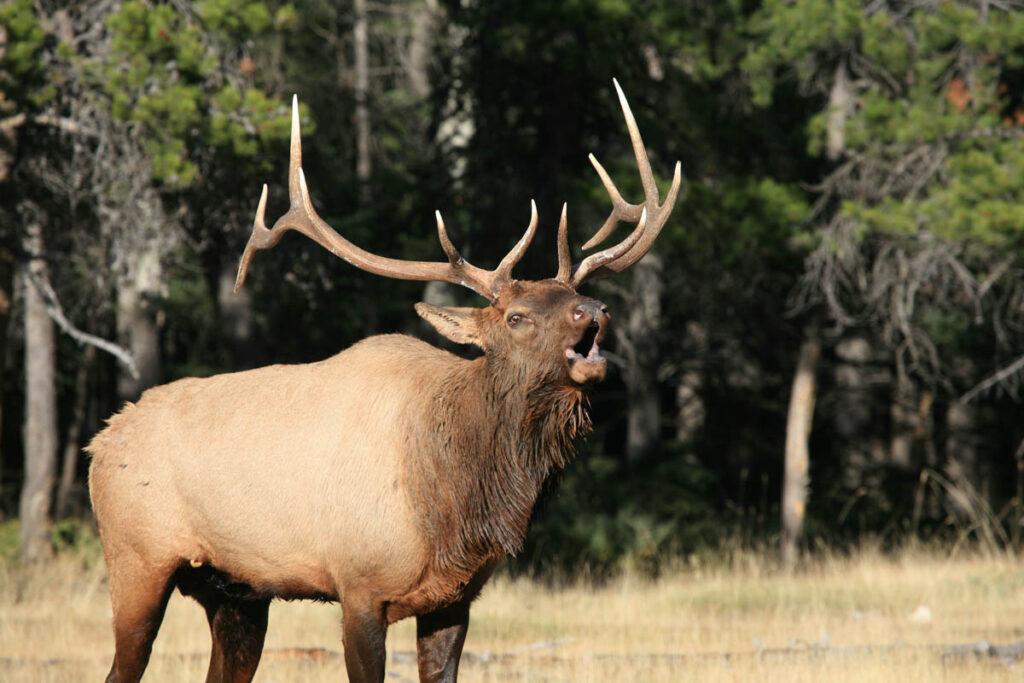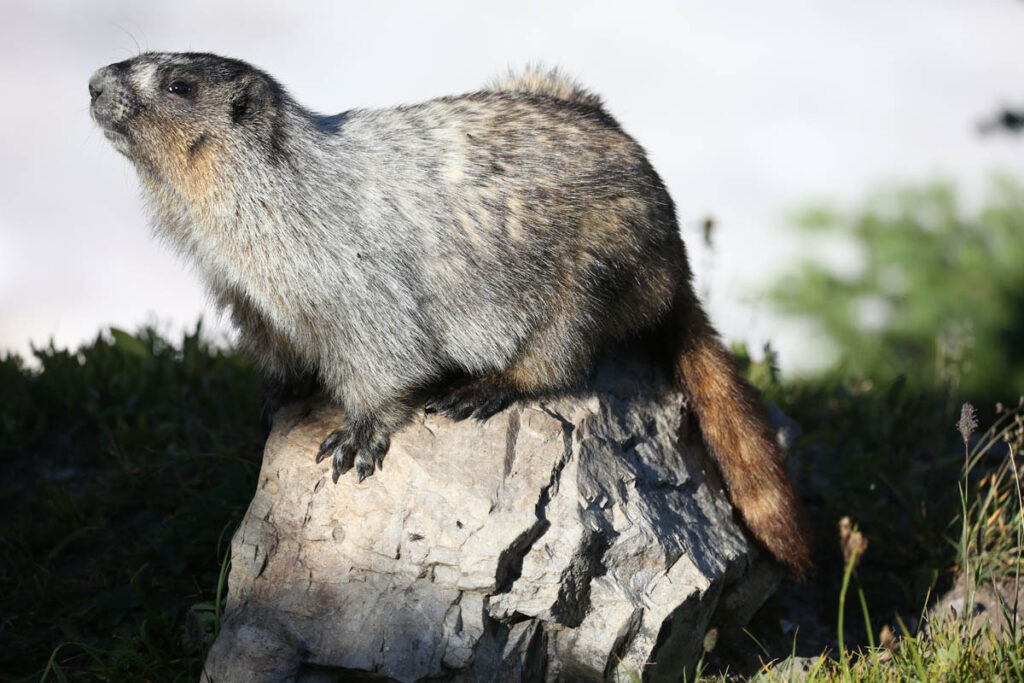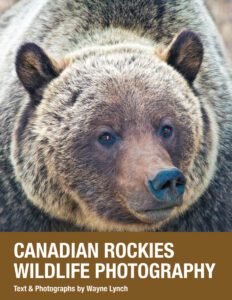Banff National Park Wildlife Viewing
Banff National Park wildlife viewing is one of the most popular visitor activities in Banff.
In summer, with the onslaught of the tourist hordes, many of the larger mammals move away from the heavily traveled areas. It then becomes a case of knowing when and where to look for them. Spring and fall are the best times of year for wildlife viewing; the crowds are thinner than in summer, and big-game animals are more likely to be seen at lower elevations. Winter also has its advantages. Although bears are hibernating, a large herd of elk winters on the outskirts of the town of Banff, coyotes are often seen roaming around town, bighorn sheep have descended from the heights, and wolf packs can be seen along the Bow Valley Corridor.
For descriptions of all wildlife species present in Banff National Park, visit our Banff National Park Nature Guide.

Elk in fall along the Golf Course Road.
Small Mammals
One of the first mammals you’re likely to come in contact with is the Columbian ground squirrel, seen throughout the park’s lower elevations. The golden-mantled ground squirrel, similar in size but with a striped back, is common at higher elevations or around rocky outcrops. The one collecting Engelmann spruce cones is the red squirrel. The least chipmunk is striped, but it’s smaller than the golden-mantled squirrel. It lives in dry, rocky areas throughout the park. Short-tailed weasels are common, but long-tailed weasels are rare. Look for both in higher subalpine forests. Pikas (commonly called rock rabbits) and hoary marmots (well known for their shrill whistles) live among rock slides near high-country lakes: look for them around Moraine Lake and along Bow Summit Loop. Porcupines are widespread and are most active at night; I often see them on early morning hikes in the vicinity of Lake Louise. Vermilion Lakes is an excellent place to view the beaver at work; the best time is dawn or dusk. Muskrats and mink are common in all wetlands within the park.

Marmots live at high elevations, such as the Helen Lake Trail.
Hoofed Residents
The most common and widespread of the park’s hoofed residents are elk, which number around 2,000. Starting in 2000, a concerted effort was made to keep them out of Banff’s downtown core, but they are still congregating around the outskirts of the town, including up near the Tunnel Mountain campgrounds. They can also be seen along the Bow Valley Parkway. Moose were once common around Vermilion Lakes, but competition from an artificially expanded elk population caused their numbers to decline, and now only around 100 live in the park. Look for them at Waterfowl Lakes and along the Icefields Parkway near Rampart Creek. Mule deer, named for their large ears, are most common in the southern part of the park. Watch for them along the Mount Norquay Road and Bow Valley Parkway. White-tailed deer are much less common but are seen occasionally at Saskatchewan River Crossing. It is estimated that the park is home to around 900 mountain goats. These nimble-footed creatures occupy all mountain peaks, living almost the entire year in the higher subalpine and alpine regions. The most accessible place to view these high-altitude hermits is along Parker’s Ridge in the far northwestern corner of the park. The park’s bighorn sheep have for the most part lost their fear of humans and often congregate at certain spots to lick salt from the road. Your best chance of seeing one of the park’s 2,000 to 2,300 bighorn is at the south end of the Bow Valley Parkway, between switchbacks on Mount Norquay Road, and between Lake Minnewanka and Two Jack Lake.
Wild Dogs and Cats
Coyotes are widespread along the entire Bow River watershed. They are attracted to Vermilion Lakes by an abundance of small game, and many have permanent dens there. Wolves had been driven close to extinction by the early 1950s, but today at least four wolf packs have been reported in the park. One pack winters close to town and is occasionally seen on Vermilion Lakes during that period. The lynx population fluctuates greatly; look for them in the backcountry during winter. Cougars are shy and number fewer than 20 in the park. They are occasionally seen along the front ranges behind Cascade Mountain.
Bears
The exhilaration of seeing one of these magnificent creatures in its natural habitat is unforgettable. From the road you’re most likely to see black bears, which actually range in colour from jet black to cinnamon brown and number around 50. Try the Bow Valley Parkway at dawn or late in the afternoon. Farther north they are occasionally seen near the road as it passes Cirrus Mountain. Banff’s 60-odd grizzly bears spend most of the year in remote valleys, often on south-facing slopes away from the Bow Valley Corridor. During late spring they are occasionally seen in residential areas, along the Lake Minnewanka loop road, on the golf course, and in the area of Bow Pass. The chance of encountering a bear face-to-face in the backcountry is remote. To lessen chances even further, you should take some simple precautions: Never hike alone or at dusk. Make lots of noise when passing through heavy vegetation. Keep a clean camp. Read the pamphlets available at all park visitors centres. At the Banff Visitor Centre (224 Banff Ave.), daily trail reports list all recent bear sightings. Report any bears you see to the Warden’s Office (403/762-4506).
Banff Wildlife Photography Book
Even if you’re not interested in photography, Canadian Rockies Wildlife Photography, an eBook by renowned wildlife photographer Wayne Lynch, is a great resource for searching out local wildlife. It includes all the very best places to view wildlife in Banff National Park.
Wildlife Safety in Banff National Park
 An abundance of wildlife is one of the biggest draws of Banff National Park. To help preserve this precious resource, obey fishing and hunting regulations and use common sense.
An abundance of wildlife is one of the biggest draws of Banff National Park. To help preserve this precious resource, obey fishing and hunting regulations and use common sense.
DO NOT FEED THE ANIMALS. Many animals may seem tame, but feeding them endangers yourself, the animal, and other visitors, as animals become aggressive when looking for handouts (even the smallest critters, such as squirrels).
STORE FOOD SAFELY. When camping, keep food in your vehicle or out of reach of animals. Just leaving it in a cooler isn’t good enough.
KEEP YOUR DISTANCE. Although it’s tempting to get close to wildlife for a better look or a photograph, it disturbs the animal and, in many cases, can be dangerous.
DRIVE CAREFULLY. The most common cause of premature death for larger mammals is being hit by vehicles, especially along the Bow Valley Parkway and Icefields Parkway, which are not fenced.
